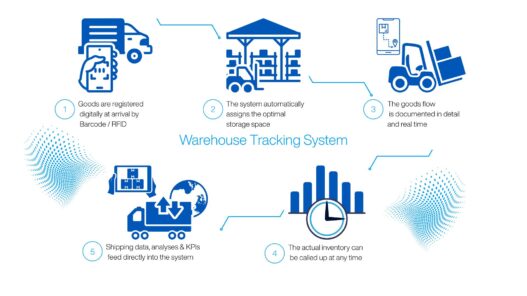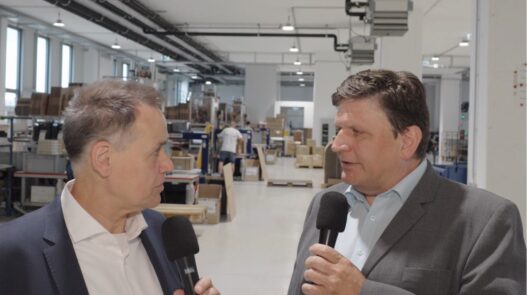What is a WTS?
A WTS is a software solution helping to track the flow of goods within a warehouse or production environment transparently and in real time. It is not just classic warehouse management; it allows the seamless tracking of each individual item from goods receipt to picking and production to shipping.
WTS systems combine hardware and software components such as:
- Mobile devices (handheld scanners, tablets, etc.)
- Sensors (e.g. RFID, IoT trackers)
- Interfaces to ERP or WMS systems
- Real-time data visualization
They aim to create transparency, accelerate processes and minimize error rates.
How does a WTS function?
A typical procedure looks like this:
- Identification and recording:
Each product or container is given a unique identifier – usually a barcode or RFID tag. This information is transferred to the WTS when goods are received. - Real-time tracking:
Movements within the warehouse (e.g. storage, transfer, picking) are registered by scanner or sensor – complete automation is possible. Modern systems even integrate location data from indoor navigation. - Data management:
All movements and inventories can be retrieved centrally. The WTS immediately detects critical situations such as overstocks, shortages or unusual movements. - Connection to ERP / WMS:
The WTS delivers precise real-time data to higher-level systems. Thus, materials management can access correct inventory figures and automatically control processes such as reorders or production releases.
What technologies are used in WTS?
Depending on the complexity and requirements, companies use different technologies:
- Barcode systems:
Simple, inexpensive, proven. Ideal for warehouses or production facilities of a manageable size. - RFID:
Contactless identification – particularly advantageous for frequent goods movements or difficult environments (e.g. metallic containers). - IoT sensor technology:
Expands the capabilities of the WTS with status data (e.g. temperature, vibration, humidity) – important for quality assurance. - Indoor tracking via RTLS (Real-Time Location Systems):
Enables the pinpoint location of goods and industrial trucks within buildings.
A well-designed WTS always selects technologies to match the logistics strategy and specific processes – not the other way around.
Practical tips based on our experience
- Define the processes at an early stage:
A WTS is based on existing processes – the better these are standardized, the easier and more successful the introduction will be. - Engage employees:
Acceptance is key. Successful projects integrate the team at an early stage and offer practical training. - Set up a pilot area:
A small test field helps to identify and eliminate stumbling blocks at an early stage. - Check integration with existing systems:
Especially the interfaces to ERP and WMS must not be underestimated – this is where quite often the success of the project is decided. - Pay attention to scalability:
One warehouse today, several tomorrow? A good WTS grows with you and remains flexible.
Frequently asked questions about WTS
What distinguishes a WTS from a classic WMS (Warehouse Management System)?
A WMS manages inventory and processes at a higher level, while a WTS enables detailed real-time tracking of individual items or transport units within the warehouse.
Does a WTS also make sense for small or medium-sized companies?
Yes! Smaller companies in particular benefit greatly from the increased efficiency and reduced error rates. Modern systems are modular and can be implemented on smaller budgets.
How long does it take to implement a WTS?
Depending on the complexity and the size of the company, this can take between a few weeks (for standard solutions) and several months (for individual adjustments).
Conclusion: WTS – the key to transparent warehouse logistics
A well-thought-out WTS not only creates transparency but is a clear strategic advantage too: faster processes, fewer errors and better decisions based on valid real-time data.
We support companies from a wide range of industries – from small family businesses to medium-sized manufacturing companies and large companies – in the successful implementation of modern WTS solutions. Our experience shows that those who invest in smart warehouse transparency today, create the basis for tomorrow – and secure competitive advantages.
Curious? Our logistics references show how individual solutions move companies – with experience, enthusiasm and a deep understanding of the requirements of a wide range of industries. Discover what we can achieve together – we look forward to a non-binding introductory meeting with you.


